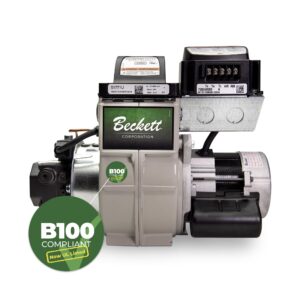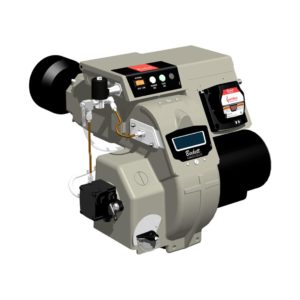In this bulletin we will address the following questions:
- What is a combustion head?
- What is a non-flame retention head and how does it work?
- What is a flame retention head and how does it work?
- What are the different types of flame retention heads?
- Which head should be used and on which units?
The combustion head (also referred to as the turbulator, fire ring, retention ring or end cone) creates a specific pattern of air at the end of the air tube. The air is directed in such a way as to force oxygen into the oil spray so the oil can burn. The combustion head is one link in the chain necessary to burn the oil efficiently. In order to do its work properly, the combustion head must have support. The blower housing must deliver the right amount of air at the proper pressure and the fuel pump and nozzle must deliver the right amount of fuel at the proper pressure. So, the combustion head is only one part in a complete system, but it is a very important part.
Non-Retention Head
Historically, the first combustion heads used were referred to as non-flame retention heads. The base of the flame is usually a good distance off the surface of the head and thus not “retained” or locked onto the head.
These heads are typically very simple in construction, usually consisting of a large hole in the end of the air tube. Some add a “spinner” or “turbulator” inside the air tube.
The spinner or turbulator creates a swirl pattern of air before passing through the large hole. This head produces a loose long flame because the velocity of the air passing through the head is so low due to the large opening in the head. As the need for higher burner efficiencies arose, the next generation of burner heads was born.
Retention Head
The majority of combustion heads in the field today are flame retention heads. These heads differ from the non-flame retention heads in that the flame is held very close to the face of the head. The flame is smaller and more compact and usually is 300° to 500°F hotter than with non-flame retention heads.
The flame retention head incorporates three basic elements. We will refer to these as (1) center opening, (2) primary slots and (3) secondary opening. The center opening is an orifice in the center of the head which allows clearance for the oil spray and the electrode spark to pass through the head without interfering with the head. The primary slots are the slots that radiate out from the center opening towards the outside of the head. The secondary opening is a slot which is concentric to the center opening and follows the circumference of the combustion head. All three openings affect the way air is delivered to the oil spray.
Retention Head Elements
The center opening has the least desirable affect on combustion. Air will always take the path of least resistance, so the larger the center opening the more the air will tend to pass through this opening and push the flame out away from the face of the head. This air travels in a forward motion only. Likewise, the smaller the center opening, the more the air will be forced to seek its passageway through the other openings in the combustion head.
The primary slots are where the most important mixing of oil and air occur. The slot width regulates the amount and the velocity of the air passing through the slot. This is where the air acquires a spinning action. This air moves mostly in a rotary motion with some forward movement. Narrow slots will cause the air to spin at a high rotary velocity and a low forward velocity. This condition will cause the best mixing of air and oil which will make the flame compact, intense and efficient. The primary slots also aid in keeping the surface of the head clean and free from carbon. The greater the number of slots, the cleaner the head will be kept because a head with many slots has smaller surfaces to keep clean.
The secondary slot performs two functions. The first is to enclose the flame in an envelope of air, thus helping to contain stray oil droplets and allow them to be burned. Some heads incorporate the use of a sleeve on the end of the tube which helps to turn the air into the flame. The second function, and probably the most important, is to meter the air necessary to achieve the required firing rate. The metering of air is accomplished through the width of the slot. The width can be varied through the use of a variety of one piece heads with a fixed secondary slot according to the firing rate for which it was designed. Or, the head must be able to move against or away from a ring thus closing or opening the secondary slot according to the firing rate requirements.
Different Types
Although there appears to be a wide variety of flame retention heads on the market and in the field, this is not the case. Most heads found today can be classified as either a fixed head or as avariable head. And, if you look closely at each group, you will discover that they are very similar. Each contains the three basic elements of construction: a center opening, primary slots and a secondary slot. The only major difference is the method of controlling the secondary opening. The fixed head group has the secondary opening preset to a specific opening size for a specific firing rate range. The variable head group allows the head to move forward and backward against a ring in order to change the secondary opening according to the firing rate requirements.
Generally speaking, it is advisable to choose a flame retention head over a non-flame retention head in the majority of applications. There are a few existing heating units in the field which have used a non-flame retention head in a steel chamber. These units can be retrofitted with a new burner and non-flame retention head or could use a flame retention head with the addition of a chamber liner as a safety feature against the hotter flame temperatures of the flame retention head. In any case, very seldom is a non-retention head used or needed.
How To Choose
Of the two types of retention heads (fixed or variable), here are some general guidelines.
The fixed head is an excellent performer in most warm air applications. Since the chamber in these units becomes red hot, any oil which is not burned in the flame is usually ignited by the heat of the chamber. As with warm air units, a fixed head will also work very well in the majority of boiler applications. It is always necessary to choose a head whose firing rate range is closely matched to the firing rate requirements of the heating unit. As an example, if the firing rate of the heating unit is 1.50 GPH and head #1 has a range of .85-1.65 GPH and head #2 has a range of 1.10-2.00 GPH, the head to choose for the highest performance would be head #1 (the .85-1.65 GPH head).
The reason is that the higher rated head #2 has a larger secondary slot than the lower rated head to enable it to reach the top end of its range. Either head will work, but the higher rated head #2 will probably not reach the same performance levels as the lower rated head because of the extra air it will allow through the secondary slot.
The variable head is also an excellent performer in most warm air applications. The type of application where the variable head goes beyond the performance capabilities of the fixed head is in the hard-to-fire boiler applications. The variable head gives the user two advantages over the fixed head. The first advantage is the ability to fine tune the position of the head so as to supply the flame with the precise amount of air through the secondary slot that it needs in order to achieve the highest performance levels. The second advantage is that most variable heads are actually recessed into
the air tube which protects the flame base from being blown off by recirculating flue gases within the chamber. This type of head is an excellent answer to the pulsating or loss of retention problem.
Summary
In general, a fixed head is simple and easy to use and, in most cases, will perform very well. Most appreciate the simplicity of the one-piece fixed head. For those few hard-to-fire applications, a variable head is a good choice. The solution of a problem far outweighs the requirement to fine tune the head. There are also some variable heads which allow you to adjust to a set position optimum for the desired rate. This eliminates the need to have an infinite number of positions to choose from.































